The Effect of Leading-Edge Wavy Shape on the Performance of Small-Scale HAWT Rotors
Abstract
:1. Introduction
1.1. Turbine Efficiency for Sustainable Energy: An Overview
1.2. Optimizing Rotor Blade Performance Using the Leading-Edge Tubercle Technique
1.3. Enhancing Airfoil Performance with Tubercles
1.4. Advancing Wind Turbine Performance with Tubercles
1.5. Problem Statement and Aims of the Research
2. Material and Methodology
2.1. Rotor Blade Geometry Generation
2.1.1. Airfoil Selection
2.1.2. Blade Design Procedure
2.2. Generation of Wavy-Shape Blade Models
2.3. Experimental Setup
2.3.1. Testing Method
2.3.2. Tunnel Blockage Correction
2.3.3. Uncertainty in the Measurement
2.4. Validation of the Proposed Rotor Model
3. Results and Discussion
3.1. Representative Power Coefficient Curve
3.2. RB1 Baseline Rotor Model and Validation
3.3. Wind Tunnel Blockage Correction
3.4. RB2 Rotor Model
3.5. RB3 Rotor Model
3.6. RB4 Rotor Model
3.7. RB5 Rotor Model
3.8. RB6 Rotor Model
4. Conclusions
- -
- The baseline rotor model (RB1) exhibited a higher peak power coefficient in comparison to the rotor model referenced from the literature. This higher coefficient was achieved for a nearly identical tip-speed ratio. Nonetheless, when considering relatively similar design parameters, such as rotor solidity, number of blades, tunnel blockage, and design tip-speed ratio, but with distinct airfoil profiles, the study’s results did not reveal any consistent patterns or trends.
- -
- Among the various leading-edge tubercle configurations investigated, the RB2 rotor model with an amplitude of 1 mm and a wavelength of 3.5 mm outperformed all other rotor models, including the baseline rotor model (RB1), across the entire range of tip-speed ratios examined in this study. For low tip-speed rations, this model demonstrated a significant performance improvement of around 40% compared to the baseline rotor model (RB1). The reduction in this advantage to approximately 2.8% occurred when the RB2 rotor model reached its peak power coefficient. The improved performance of the RB2 rotor model compared to the RB1 rotor model can be attributed to factors such as the increased number of bumps, their subtle dimensions, and enhanced surface roughness. These characteristics collectively altered the airflow structure, influencing both chordwise and spanwise directions. This effect was particularly pronounced during high flow speeds, aligning with findings highlighted in the literature review. Furthermore, it is apparent that the configuration, along with the subtle disparity in the amplitudes of the initial and terminal bumps situated at both blade ends, play a crucial role. According to the existing literature, these specific characteristics can influence the intensity of root and tip vortices of the blade, particularly under conditions of elevated flow speeds.
- -
- The RB3 rotor model demonstrated its effectiveness primarily within the range of smaller values of tip-speed ratios, approximately up to 3.5, when compared to the RB1 rotor model.
- -
- A marginal advantage of the RB4 rotor model over RB1 was observed at tip-speed ratios up to 3.15 and beyond 4.21.
- -
- As the amplitude and wavelength are further increased, the rotor’s efficiency experiences a relatively gradual decline, while still maintaining the general shape of the curve.
Author Contributions
Funding
Data Availability Statement
Conflicts of Interest
Nomenclature
| angle of attack | |
| wave amplitude | |
| rotor swept area | |
| cross-sectional area of test section | |
| local twist angle | |
| number of blades | |
| tunnel blockage | |
| average chord length of the blade | |
| local chord | |
| lift coefficient | |
| drag coefficient | |
| power coefficient | |
| local inflow angle | |
| tip-speed ratio | |
| local tip-speed ratio | |
| wavelength | |
| dynamic viscosity of the air | |
| number of blade elements | |
| local radius | |
| rotor radius | |
| Reynolds number | |
| air density | |
| rotor solidity | |
| sine wave equation | |
| location of the starting point of the sine wave path | |
| blade-tip speed | |
| relative velocity | |
| wind speed | |
| extension of the bumps from root to the blade tip |
References
- Emeis, S. Wind Energy Meteorology; Springer: Berlin/Heidelberg, Germany, 2013; ISBN 978-3-642-30522-1. [Google Scholar]
- Gharaati, M.; Xiao, S.; Wei, N.J.; Martínez-Tossas, L.A.; Dabiri, J.O.; Yang, D. Large-eddy simulation of helical- and straight-bladed vertical-axis wind turbines in boundary layer turbulence. J. Renew. Sustain. Energy 2022, 14, 053301. [Google Scholar] [CrossRef]
- Statista.com. Available online: https://www.statista.com/statistics/269885/capacity-of-small-wind-turbines-worldwide/ (accessed on 15 January 2023).
- Shah, H.; Mathew, S.; Lim, C.M. A novel low reynolds number airfoil design for small horizontal axis wind turbines. Wind Eng. 2014, 38, 377–391. [Google Scholar] [CrossRef]
- Wood, D. Small Wind Turbines: Analysis, Design, and Application (Green Energy and Technology); Springer: Berlin/Heidelberg, Germany, 2011. [Google Scholar]
- Kishore, R.; Stewart, C. Priya Wind Energy Harvesting: Micro-to-Small Scale Turbines; Walter de Gruyter GmbH & Co KG: Berlin, Germany, 2018. [Google Scholar]
- Winslow, J.; Otsuka, H.; Govindarajan, B.; Chopra, I. Basic Understanding of Airfoil Characteristics at Low Reynolds Numbers (104–105). J. Aircr. 2018, 55, 1050–1061. [Google Scholar] [CrossRef]
- Giguère, P.; Selig, M.S. Low Reynolds number airfoils for small horizontal axis wind turbines. Wind Eng. 1997, 21, 367–380. [Google Scholar]
- Van Treuren, K.W. Small-scale wind turbine testing in wind tunnels under low reynolds number conditions. J. Energy Resour. Technol. Trans. ASME 2015, 137, 051208. [Google Scholar] [CrossRef]
- Hau, E. Wind Turbines: Fundamentals, Technologies, Application, Economics; Springer Science & Business Media: Berlin/Heidelberg, Germany, 2013; ISBN 9783642271519. [Google Scholar]
- Schmitz, S. Aerodynamics of Wind Turbines: A Physical Basis for Analysis and Design; Wiley: Hoboken, NJ, USA, 2020; ISBN 9781119405597. [Google Scholar]
- Miklosovic, D.S.; Murray, M.M.; Howle, L.E.; Fish, F.E. Leading-edge tubercles delay stall on humpback whale (Megaptera novaeangliae) flippers. Phys. Fluids 2004, 16, L39–L42. [Google Scholar] [CrossRef]
- Fish, F.E.; Battle, J.M. Hydrodynamic design of the humpback whale flipper. J. Morphol. 1995, 225, 51–60. [Google Scholar] [CrossRef]
- Lissaman, P.B.S. Low-Reynolds-number airfoils. Annu. Rev. Fluid Mech. 1983, 15, 223–239. [Google Scholar] [CrossRef]
- Burton, T.; Jenkins, N.; Sharpe, D.; Bossanyi, E. Wind Energy Handbook, 2nd ed.; John Wiley & Sons: Hoboken, NJ, USA, 2011; ISBN 9780470699751. [Google Scholar]
- Manwell, J.F.; McGowan, J.G.; Rogers, A.L. Wind Energy Explained: Theory, Design and Application; John Wiley & Sons: Hoboken, NJ, USA, 2010; ISBN 9780470015001. [Google Scholar]
- Hansen, M.O.L. Aerodynamics and Design of Horizontal-Axis Wind Turbines. In Wind Energy Engineering: A Handbook for Onshore and Offshore Wind Turbines; Academic Press: Cambridge, MA, USA, 2017; ISBN 9780128094297. [Google Scholar]
- McLean, D. Understanding Aerodynamics: Arguing from the Real Physics; Wiley: Hoboken, NJ, USA, 2012; ISBN 9781118454220. [Google Scholar]
- Mathew, S.; Geeta Susan, P. Advances in Wind Energy Conversion Technology; Springer Science & Business Media: Berlin/Heidelberg, Germany, 2011; ISBN 978-3-540-88257-2. [Google Scholar]
- Burdett, T.; Gregg, J.; Van Treuren, K. A Numerical Study on Improving Airfoil Performance at Low Reynolds Numbers for Small-Scale Wind Turbines using Intentional Roughness. In Proceedings of the 50th AIAA Aerospace Sciences Meeting Including the New Horizons Forum and Aerospace Exposition, Nashville, TN, USA, 9–12 January 2012; American Institute of Aeronautics and Astronautics: Reston, VA, USA, 2012. [Google Scholar]
- Primrose, S.B. Biomimetics: Nature-Inspired Design and Innovation; Wiley: Hoboken, NJ, USA, 2020; ISBN 9781119683322. [Google Scholar]
- Miklosovic, D.S.; Murray, M.M.; Howle, L.E. Experimental evaluation of sinusoidal leading edges. J. Aircr. 2007, 44, 1404–1408. [Google Scholar] [CrossRef]
- Bolzon, M.D.P.; Kelso, R.M.; Arjomandi, M. Formation of vortices on a tubercled wing, and their effects on drag. Aerosp. Sci. Technol. 2016, 56, 46–55. [Google Scholar] [CrossRef]
- Haque, M.N.; Ali, M.; Ara, I. Experimental Investigation on the Performance of NACA 4412 Aerofoil with Curved Leading Edge Planform. Procedia Eng. 2015, 105, 232–240. [Google Scholar] [CrossRef]
- Hansen, K.L.; Kelso, R.M.; Dally, B.B. Performance variations of leading-edge tubercles for distinct airfoil profiles. AIAA J. 2011, 49, 185–194. [Google Scholar] [CrossRef]
- Sudhakar, S.; Venkatakrishnan, L.; Ramesh, O.N. The influence of leading-edge tubercles on airfoil performance at low Reynolds numbers. In Proceedings of the AIAA SciTech 2020 Forum, Orlando, FL, USA, 6–10 January 2020. [Google Scholar]
- Johari, H.; Henoch, C.; Custodio, D.; Levshin, A. Effects of leading-edge protuberances on airfoil performance. AIAA J. 2007, 45, 2634–2642. [Google Scholar] [CrossRef]
- Guerreiro, J.L.E.; Sousa, J.M.M. Low-Reynolds-Number Effects in Passive Stall Control Using Sinusoidal Leading Edges. AIAA J. 2012, 50, 461–469. [Google Scholar] [CrossRef]
- Wei, Z.; New, T.H.; Cui, Y.D. An experimental study on flow separation control of hydrofoils with leading-edge tubercles at low Reynolds number. Ocean Eng. 2015, 108, 336–349. [Google Scholar] [CrossRef]
- Bolzon, M.D.; Kelso, R.M.; Arjomandi, M. The effects of tubercles on swept wing performance at low angles of attack. In Proceedings of the 19th Australasian Fluid Mechanics Conference (AFMC 2014), Melbourne, Australia, 8–11 November 2014. [Google Scholar]
- Natarajan, K.; Sudhakar, S.; Paulpandian, S. Experimental Studies On The Effect Of Leading Edge Tubercles On Laminar Separation Bubble. In Proceedings of the 52nd Aerospace Sciences Meeting, National Harbor, MD, UDA, 13–17 January 2014; American Institute of Aeronautics and Astronautics: Reston, VA, USA, 2014. [Google Scholar]
- Gasch, R.; Twele, J. Wind Power Plants: Fundamentals, Design, Construction and Operation, 2nd ed.; Springer Science & Business Media: Berlin/Heidelberg, Germany, 2012; ISBN 9783642229381. [Google Scholar]
- Rosato, M.A. Small Wind Turbines for Electricity and Irrigation; CRC Press: Boca Raton, FL, USA, 2018. [Google Scholar]
- Herráez, I.; Akay, B.; van Bussel, G.J.W.; Peinke, J.; Stoevesandt, B. Detailed analysis of the blade root flow of a horizontal axis wind turbine. Wind Energy Sci. 2016, 1, 89–100. [Google Scholar] [CrossRef]
- Branlard, E. Wind Turbine Tip-Loss Corrections: Review, Implementation and Investigation of New Models. Master’s Thesis, Technical University of Denmark, Lyngby, Denmark, 2011. [Google Scholar]
- Døssing, M.; Madsen, H.A.; Bak, C. Aerodynamic optimization of wind turbine rotors using a blade element momentum method with corrections for wake rotation and expansion. Wind Energy 2012, 15, 563–574. [Google Scholar] [CrossRef]
- Abate, G.; Mavris, D.N.; Sankar, L.N. Performance effects of leading edge tubercles on the NREL Phase VI wind turbine blade. J. Energy Resour. Technol. Trans. ASME 2019, 141, 051206. [Google Scholar] [CrossRef]
- Carreira Pedro, H.; Kobayashi, M. Numerical Study of Stall Delay on Humpback Whale Flippers. In Proceedings of the 46th AIAA Aerospace Sciences Meeting and Exhibit, Reno, NV, USA, 7–10 January 2008; American Institute of Aeronautics and Astronautics: Reston, VA, USA, 2008. [Google Scholar]
- van Nierop, E.A.; Alben, S.; Brenner, M.P. How Bumps on Whale Flippers Delay Stall: An Aerodynamic Model. Phys. Rev. Lett. 2008, 100, 054502. [Google Scholar] [CrossRef]
- Abate, G.; Mavris, D.N. Performance Analysis of Different Positions of Leading Edge Tubercles on a Wind Turbine Blade. In Proceedings of the 2018 Wind Energy Symposium, Kissimmee, FL, USA, 8–12 January 2018; American Institute of Aeronautics and Astronautics: Reston, VA, USA, 2018. [Google Scholar]
- Zhang, R.-K.; Wu, V.D.J.-Z. Aerodynamic characteristics of wind turbine blades with a sinusoidal leading edge. Wind Energy 2012, 15, 407–424. [Google Scholar] [CrossRef]
- Huang, G.-Y.; Shiah, Y.C.; Bai, C.-J.; Chong, W.T. Experimental study of the protuberance effect on the blade performance of a small horizontal axis wind turbine. J. Wind Eng. Ind. Aerodyn. 2015, 147, 202–211. [Google Scholar] [CrossRef]
- Kim, H.; Kim, J.; Choi, H. Flow structure modifications by leading-edge tubercles on a 3D wing. Bioinspir. Biomim. 2018, 13, 066011. [Google Scholar] [CrossRef] [PubMed]
- Ng, B.F.; New, T.H.D.; Palacios, R. Bio-inspired Leading-Edge Tubercles to Improve Fatigue Life in Horizontal Axis Wind Turbine Blades. In Proceedings of the 35th Wind Energy Symposium, Grapevine, TX, USA, 9–13 January 2017; American Institute of Aeronautics and Astronautics: Reston, VA, USA, 2017. [Google Scholar]
- Sunada, S.; Sakaguchi, A.; Kawachi, K. Airfoil Section Characteristics at a Low Reynolds Number. J. Fluids Eng. 1997, 119, 129–135. [Google Scholar] [CrossRef]
- Morina, R. Development of a Horizontal Axis Wind Turbine Blade Profile Based on Passive Flow Control Methods. Ph.D. Thesis, Niğde Ömer Halisdemir University, Niğde, Turkey, 2021. [Google Scholar]
- Tangler, J.; Somers, D. NREL Airfoil Families for HAWTs; National Renewable Energy Lab. (NREL): Golden, CO, USA, 1995. [Google Scholar]
- Brusca, S.; Lanzafame, R.; Messina, M. Flow similitude laws applied to wind turbines through blade element momentum theory numerical codes. Int. J. Energy Environ. Eng. 2014, 5, 313–322. [Google Scholar] [CrossRef]
- Duquette, M.M.; Swanson, J.; Visser, K.D. Solidity and blade number effects on a fixed pitch, 50W horizontal axis wind turbine. Wind Eng. 2003, 27, 299–316. [Google Scholar] [CrossRef]
- Bakırcı, M.; Yılmaz, S. Theoretical and computational investigations of the optimal tip-speed ratio of horizontal-axis wind turbines. Eng. Sci. Technol. Int. J. 2018, 21, 1128–1142. [Google Scholar] [CrossRef]
- Burdet, T.A.; Van Treuren, K.W. Scaling small-scale wind turbines for wind tunnel testing. In Proceedings of the ASME Turbo Expo 2012: Turbine Technical Conference and Exposition, Copenhagen, Denmark, 11–15 June 2012. [Google Scholar]
- Burdett, T.A.; Van Treuren, K.W. A Theoretical and Experimental Comparison of Optimizing Angle of Twist Using BET and BEMT. In Proceedings of the ASME Turbo Expo 2012: Turbine Technical Conference and Exposition, Copenhagen, Denmark, 11–15 June 2012; Volume 6: Oil and Gas Applications; Concentrating Solar Power Plants; Steam Turbines; Wind Energy. American Society of Mechanical Engineers: New York, NY, USA, 2012; pp. 797–809. [Google Scholar]
- Post, S.; Boirum, C. A Model Wind Turbine Design-Build-Test Project. In Proceedings of the ASME 2011 International Mechanical Engineering Congress and Exposition, Denver, CO, USA, 11–17 November 2011; Volume 5: Engineering Education and Professional Development. ASME: New York, NY, USA, 2011; pp. 213–218. [Google Scholar]
- Katz, J. Automotive Aerodynamics; Kurfess, T., Ed.; Wiley: Hoboken, NJ, USA, 2016; ISBN 9781119185727. [Google Scholar]
- Coleman, H.W.; Steele, W.G. Experimentation, Validation, and Uncertainty Analysis for Engineers: Fourth Edition; John Wiley & Sons: Hoboken, NJ, USA, 2018; ISBN 9781119417989. [Google Scholar]
- Lanzafame, R.; Mauro, S.; Messina, M. Numerical and experimental analysis of micro HAWTs designed for wind tunnel applications. Int. J. Energy Environ. Eng. 2016, 7, 199–210. [Google Scholar] [CrossRef]

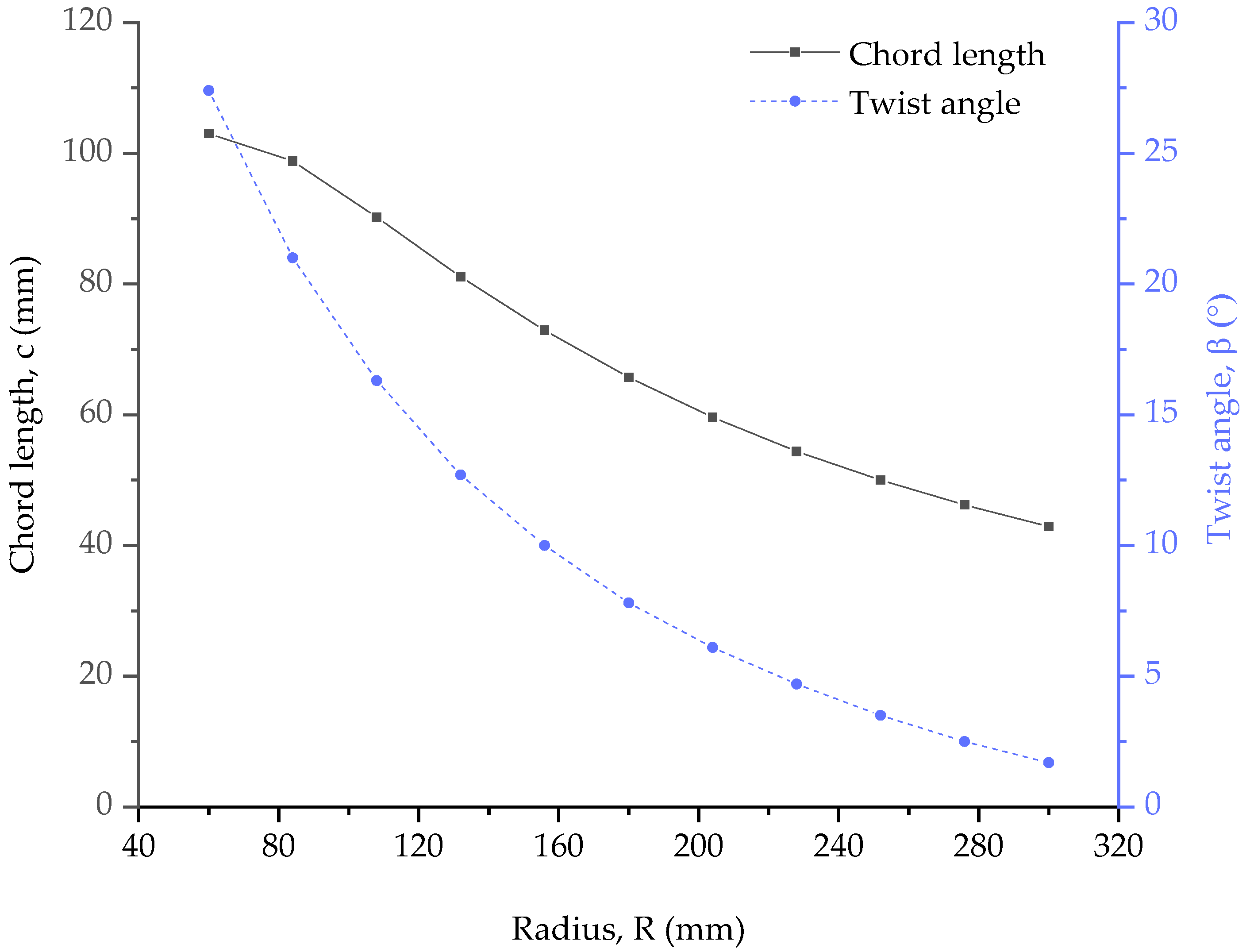
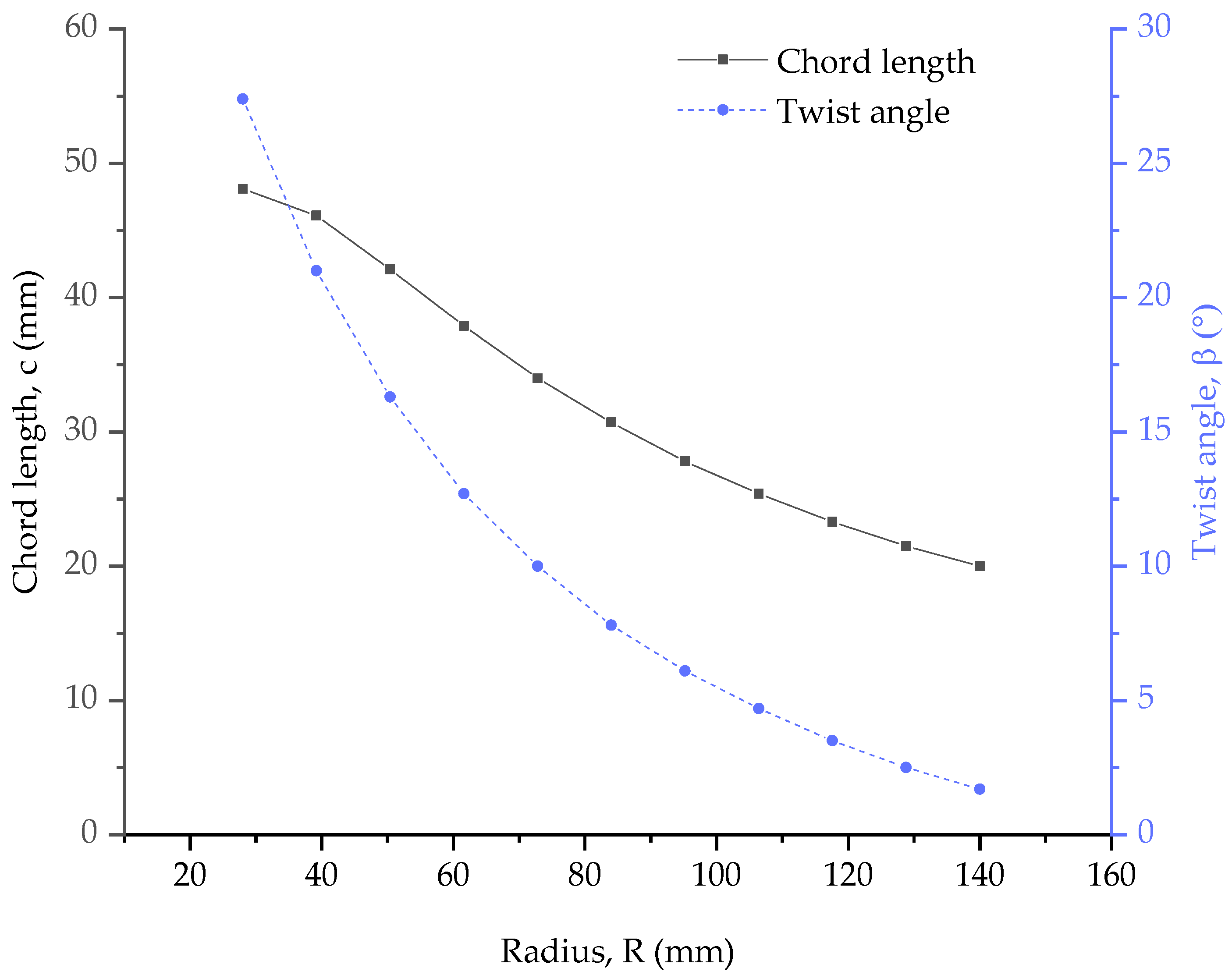
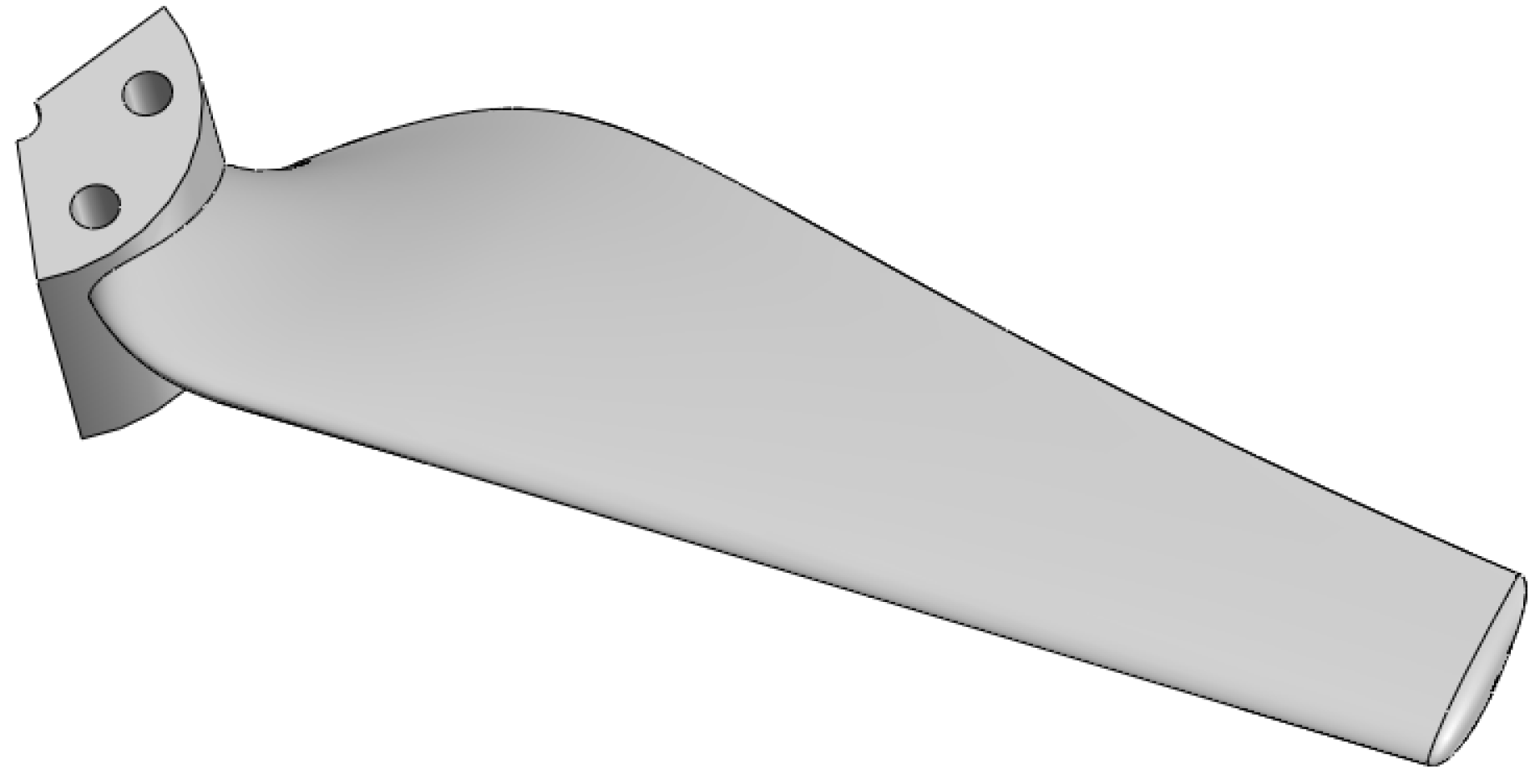
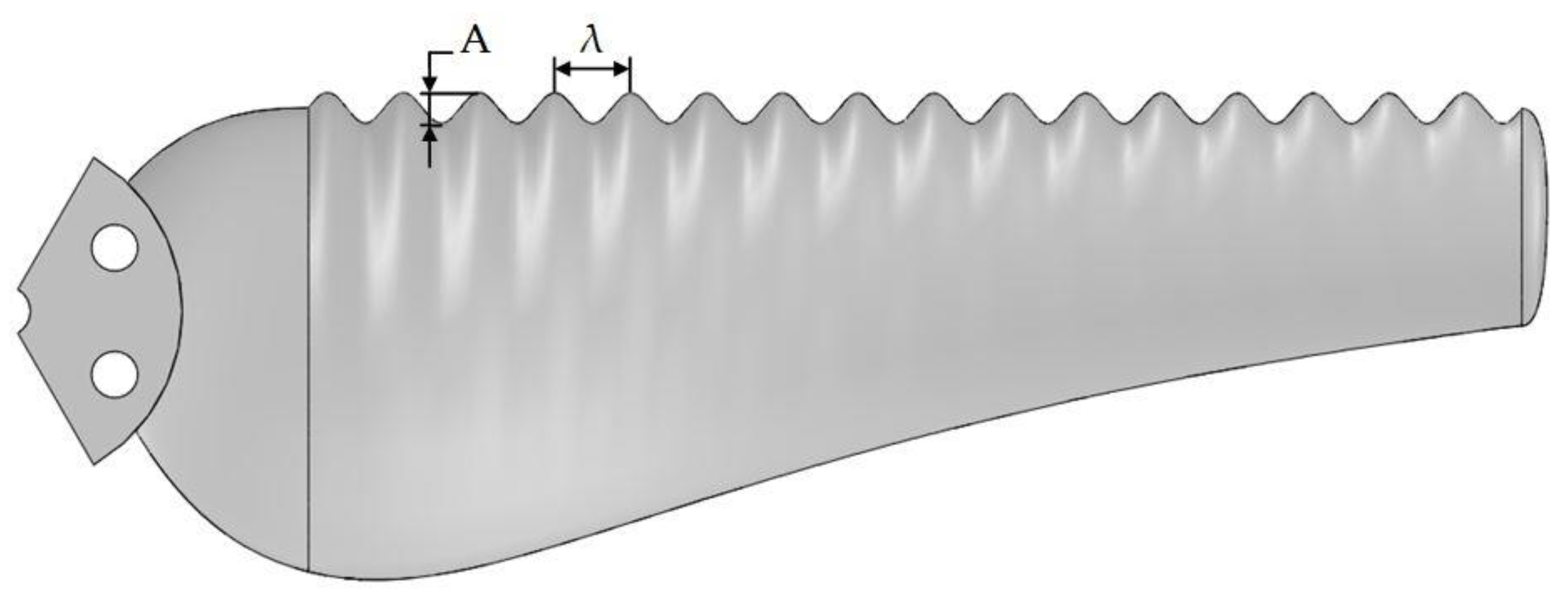


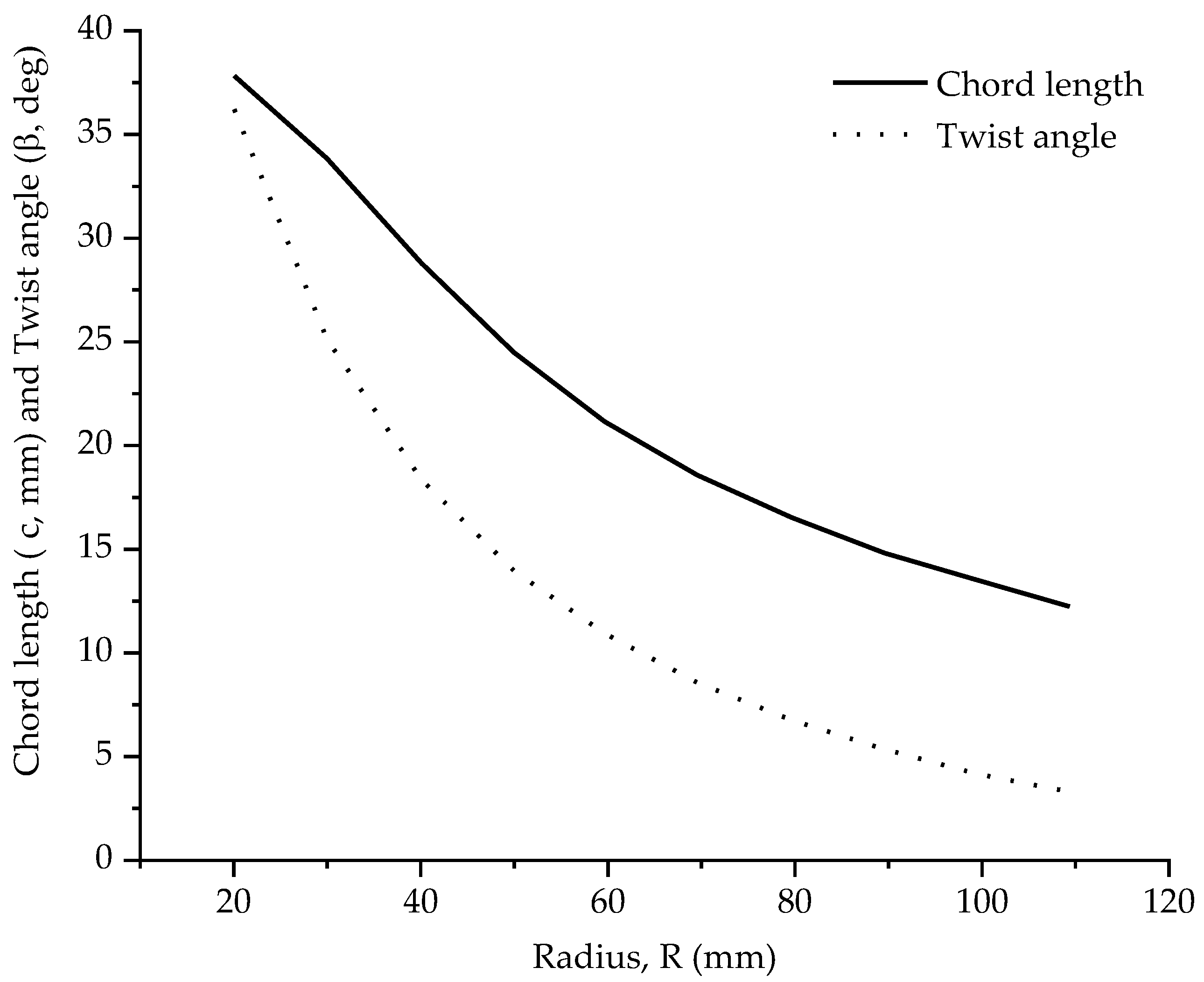
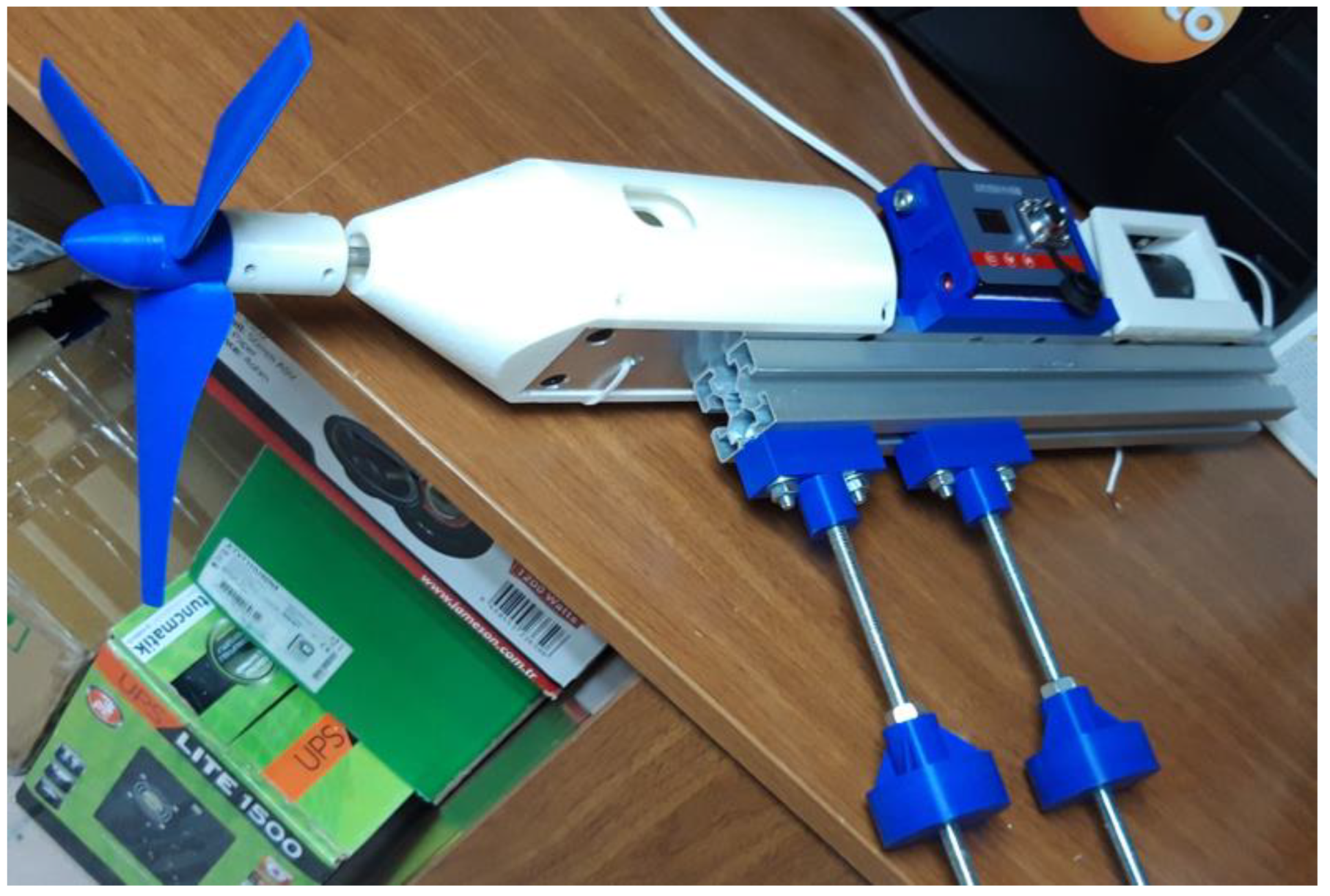
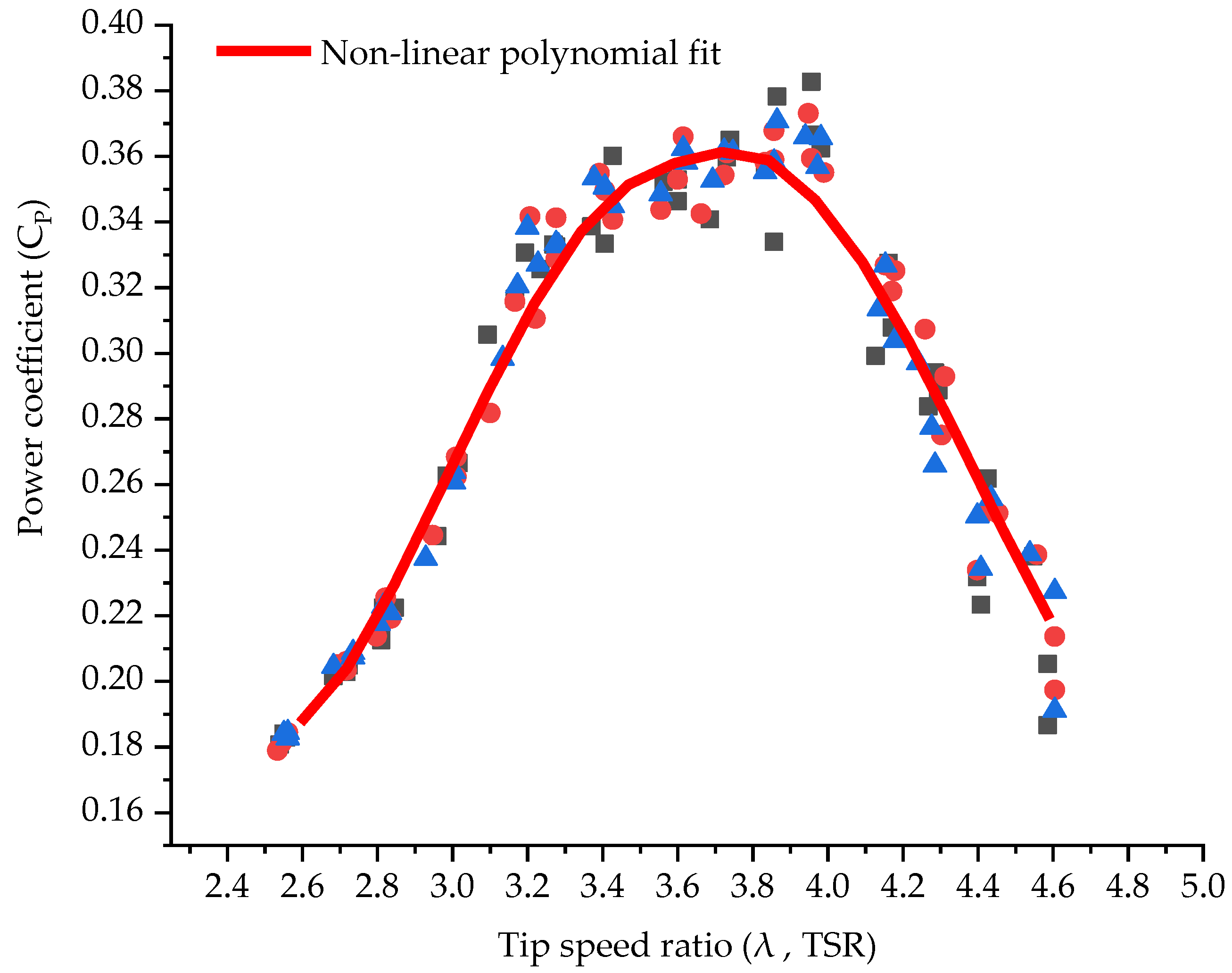

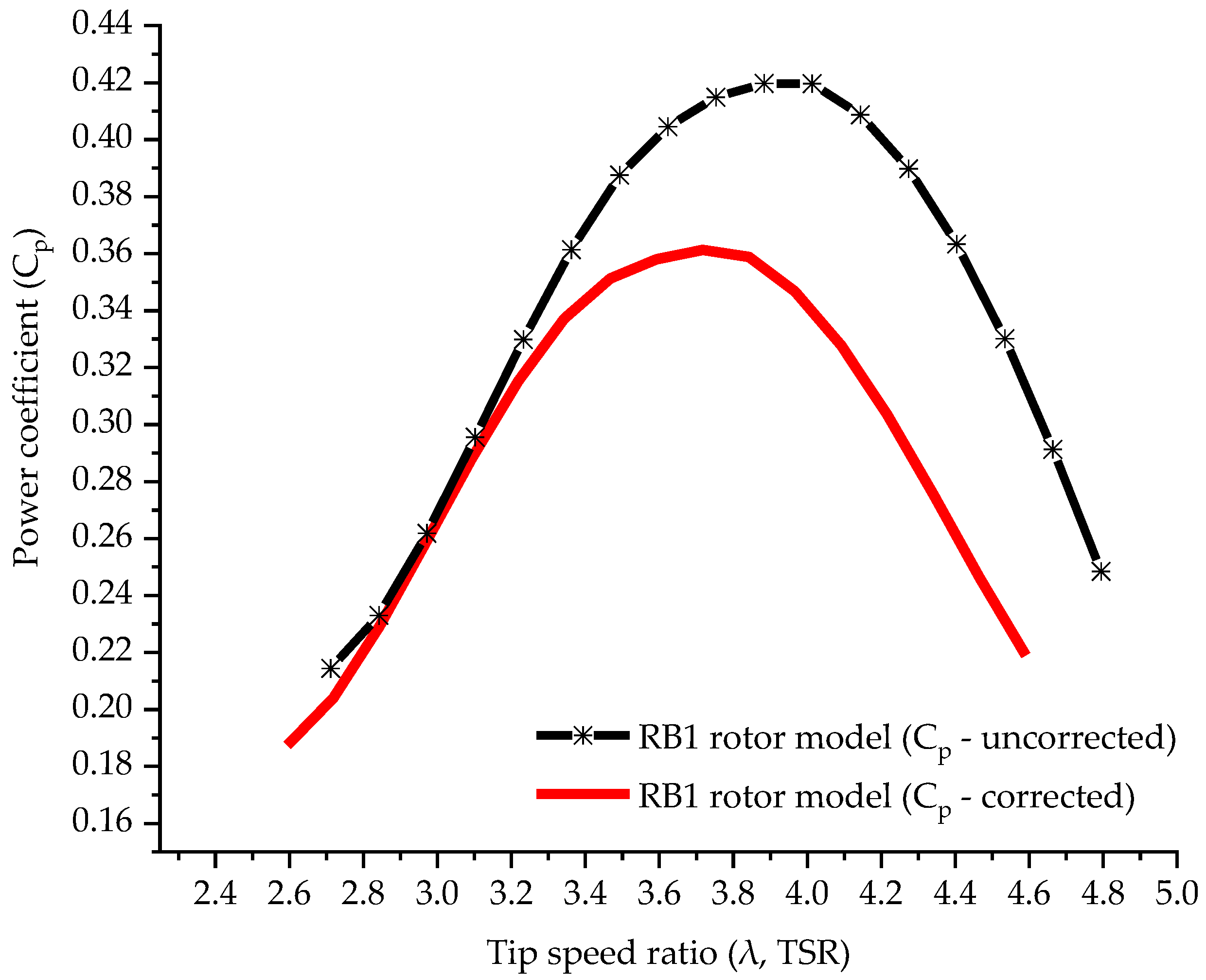
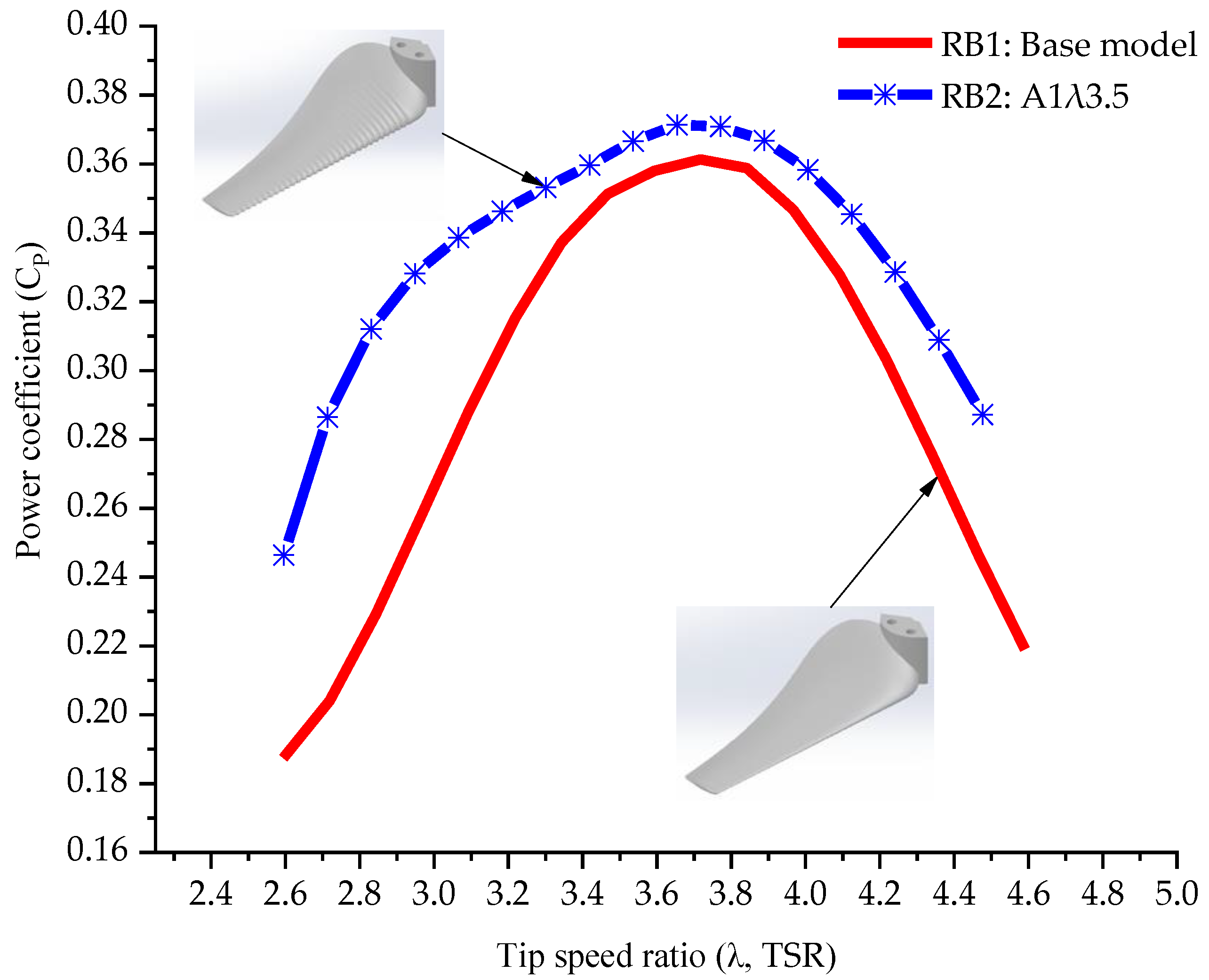

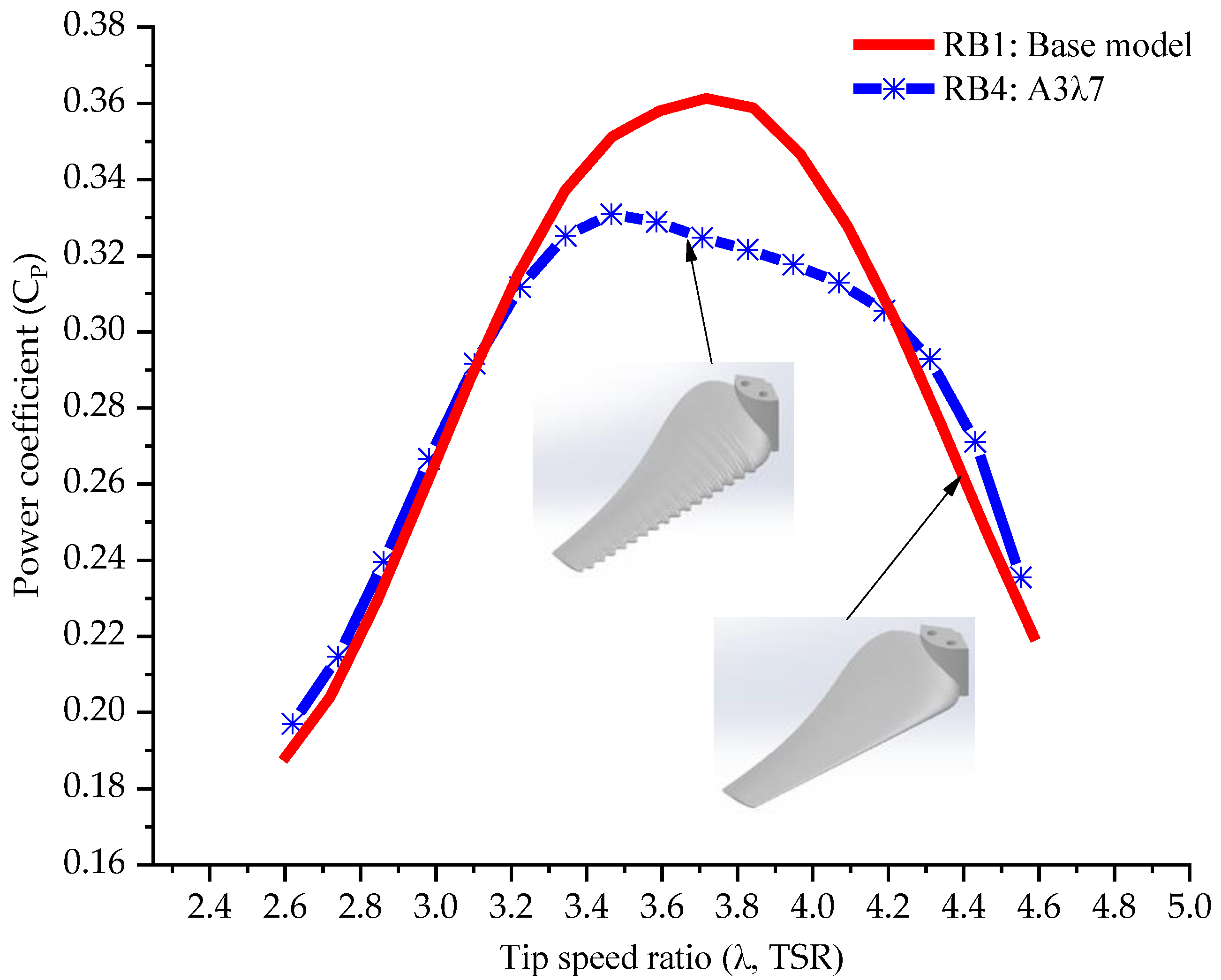
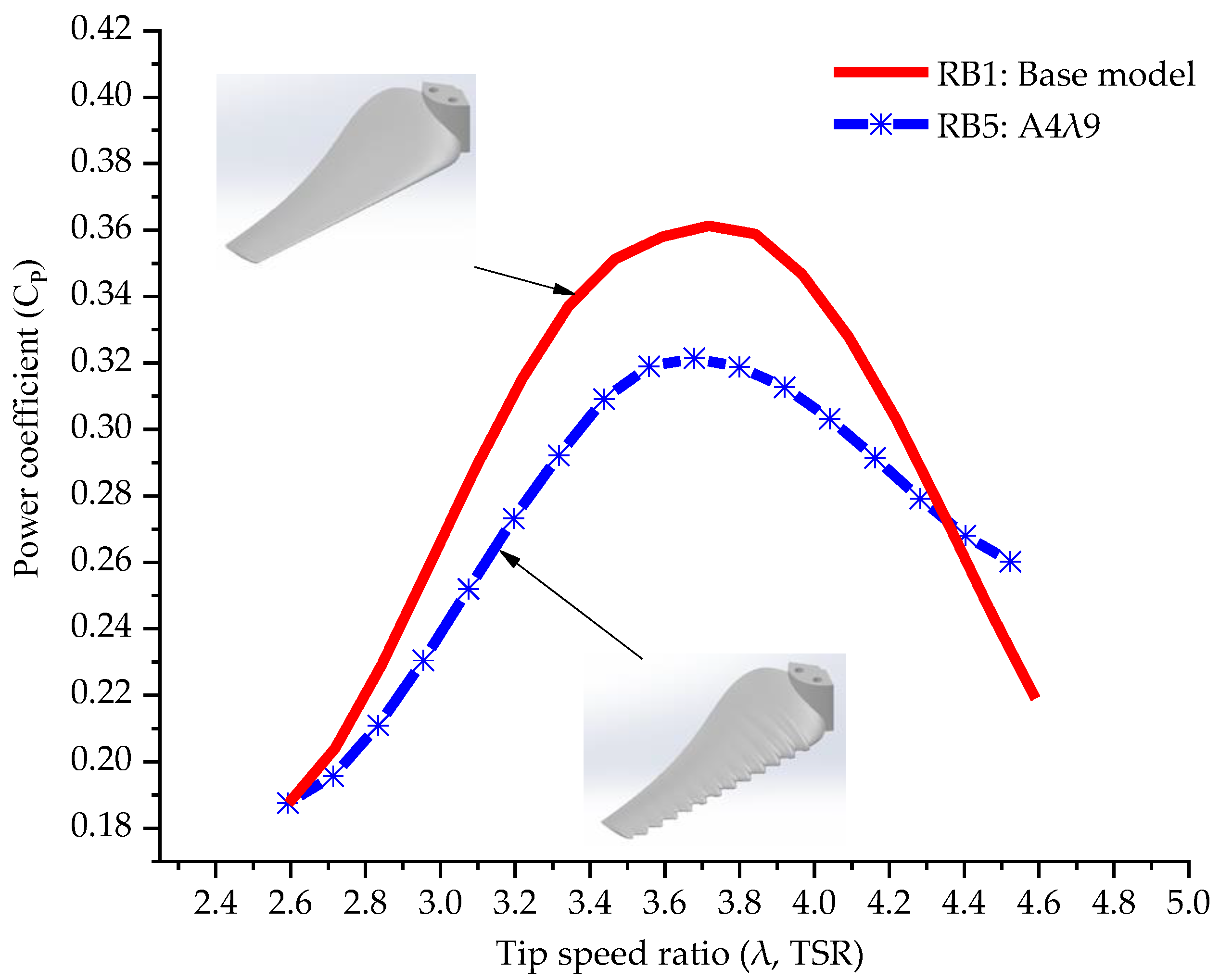

| Parameter | Value |
|---|---|
| Rotor radius (R), mm | 300 |
| Wind speed (V∞), m/s | 9 |
| Air density (ρ), kg/m3 | 1.225 |
| Reynolds number (Re) | 1 × 105 |
| Number of blades (B) | 3 |
| Tip-speed ratio (TSR, λ) | 3.658 |
| Rotor solidity (σ), % | 22.1 |
| Lift coefficient (CL) | 0.9256 |
| Drag coefficient (CD) | 0.02168 |
| Angle of attack (α), ° | 8.5 |
| Lift/drag ratio (CL/CD) | 42.7 |
| No. blade elements (N) | 10 |
| RB1—Base Model | RB2—A1λ3.5 |
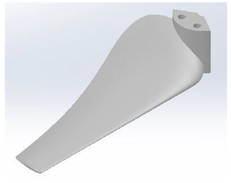 | 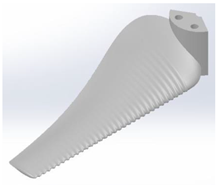 |
| RB3—A2λ5 | RB4—A3λ7 |
 | 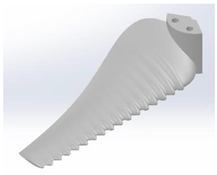 |
| RB5—A4λ9 | RB6—A5λ14 |
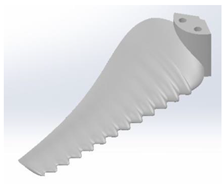 | 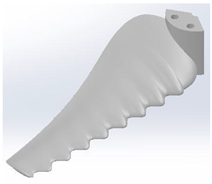 |
Disclaimer/Publisher’s Note: The statements, opinions and data contained in all publications are solely those of the individual author(s) and contributor(s) and not of MDPI and/or the editor(s). MDPI and/or the editor(s) disclaim responsibility for any injury to people or property resulting from any ideas, methods, instructions or products referred to in the content. |
© 2023 by the authors. Licensee MDPI, Basel, Switzerland. This article is an open access article distributed under the terms and conditions of the Creative Commons Attribution (CC BY) license (https://creativecommons.org/licenses/by/4.0/).
Share and Cite
Morina, R.; Akansu, Y.E. The Effect of Leading-Edge Wavy Shape on the Performance of Small-Scale HAWT Rotors. Energies 2023, 16, 6405. https://doi.org/10.3390/en16176405
Morina R, Akansu YE. The Effect of Leading-Edge Wavy Shape on the Performance of Small-Scale HAWT Rotors. Energies. 2023; 16(17):6405. https://doi.org/10.3390/en16176405
Chicago/Turabian StyleMorina, Riad, and Yahya Erkan Akansu. 2023. "The Effect of Leading-Edge Wavy Shape on the Performance of Small-Scale HAWT Rotors" Energies 16, no. 17: 6405. https://doi.org/10.3390/en16176405
APA StyleMorina, R., & Akansu, Y. E. (2023). The Effect of Leading-Edge Wavy Shape on the Performance of Small-Scale HAWT Rotors. Energies, 16(17), 6405. https://doi.org/10.3390/en16176405






